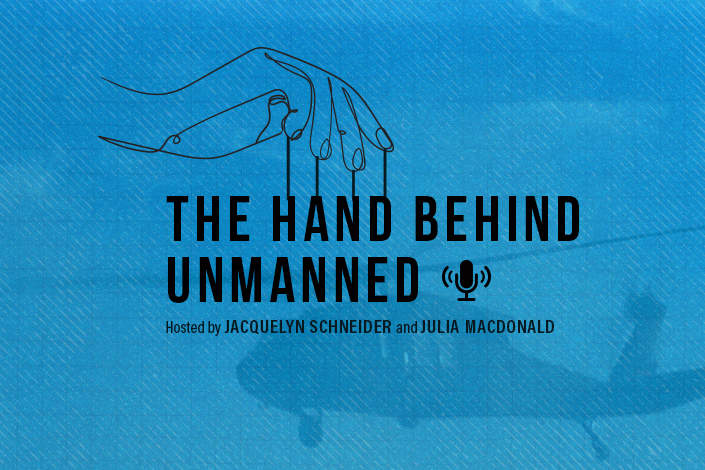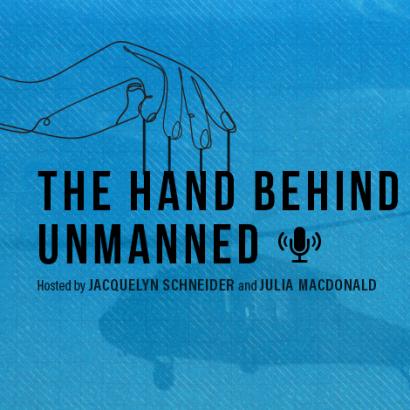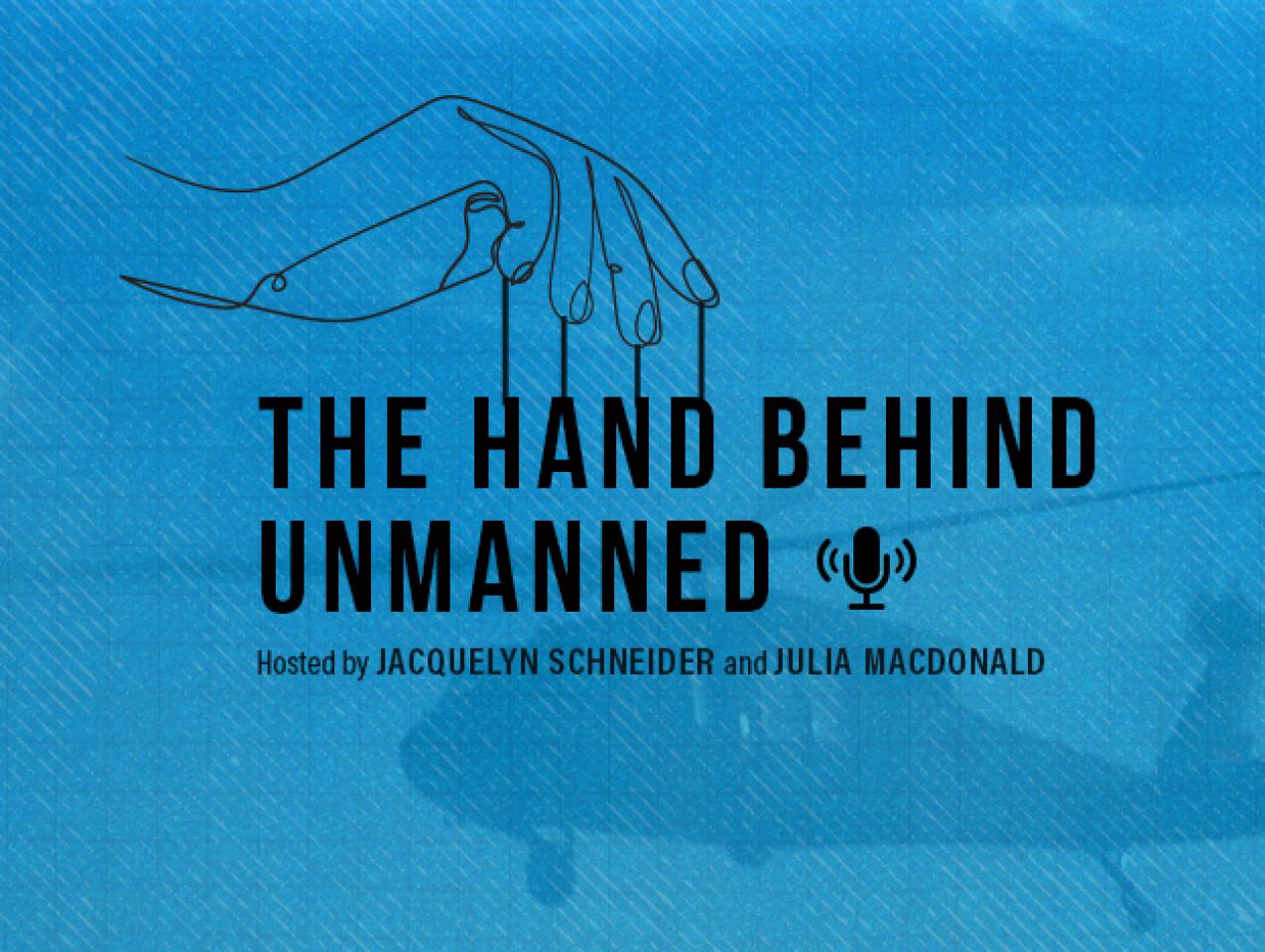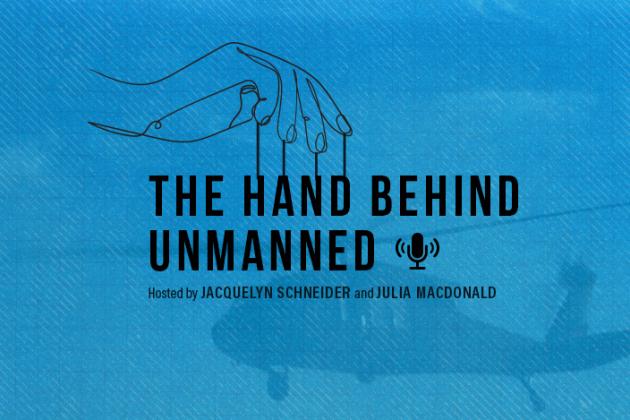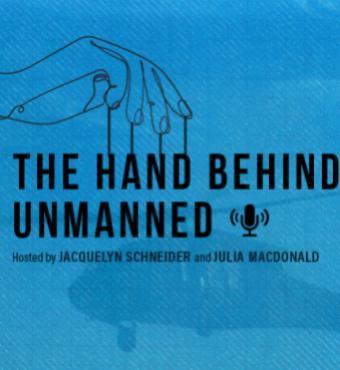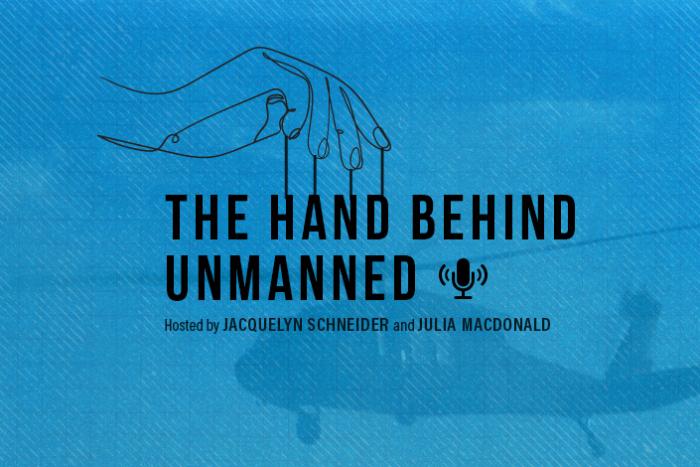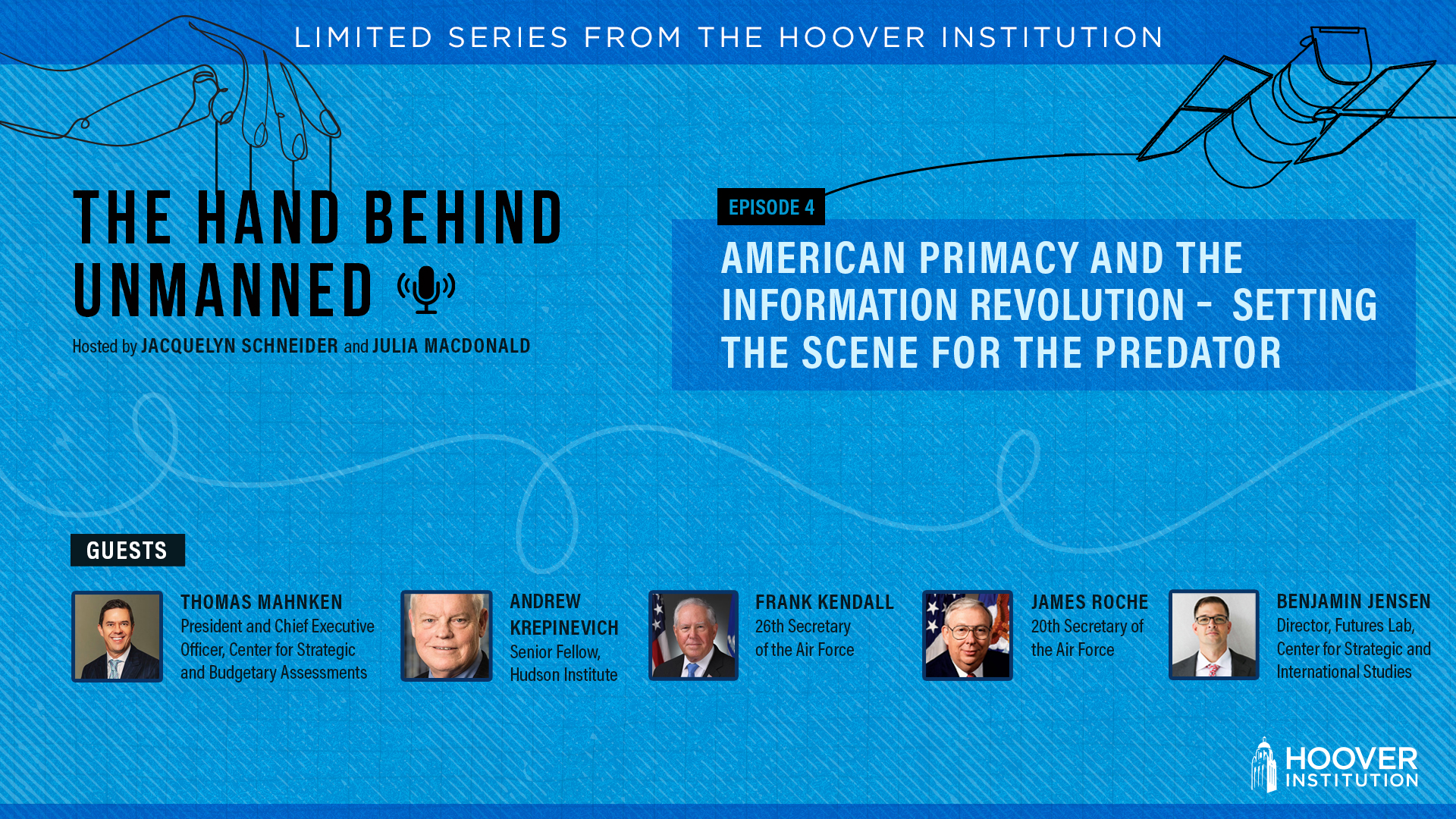It is 1989. The US has won the Cold War and is about to have a dramatic victory in Iraq. Meanwhile, in the bowels of the Pentagon, a small office of ivy league elites headed by career bureaucrat Andy Marshall, introduces a new idea about the burgeoning information technology revolution in the American military. In what are called “revolutions in military affairs,” these civilians predict a world of rapid, precise wars fought on the backbone of new technologies like unmanned systems. These beliefs get a stunning endorsement in the Gulf War which ushers in a golden age for precision-guided munitions, cruise missiles, space-based navigation, and the birth of a small but promising company, General Atomics.
WATCH THE EPISODE
>> Julie Macdonald: Episode 4, American Primacy and the Information Revolution. Setting the Scene for the Predator.
>> Speaker 2: The operation underway tonight, taking place in the predawn darkness of the Persian Gulf, involves allied air forces of four nations. The United States, the United Kingdom, Saudi Arabia and Kuwait. As they undertake their missions, they do so after months of careful planning at the direction of the President.
Great care has been taken to focus on military targets to minimize US casualties and to do everything possible to avoid injury to civilians in Iraq and Kuwait.
>> Jacquelyn Schneider: Welcome to the Hand Behind Unmanned, a podcast about how America fights war without human beings. Told from the perspective of the human beings making those choices.
I'm Jackie Schneider.
>> Julie Macdonald: And I'm Julia Macdonald. In this podcast, we take you inside weapons budget lines and behind classified program doors to understand not only what unmanned technology the US Military bought, but why. For those of you who came for the technology, we hope you'll stay for the people.
Because this really is a story about remarkable humans, historical junctures and our beliefs about the future of war and what that means for unmanned weapons we buy.
>> Jacquelyn Schneider: Along the way in our unmanned journey, we'll learn valuable lessons about how technology shapes the winners and losers in war.
How humans and technology interact at a time when the march of technological progress seems inevitable, how public funds get invested when it comes to warfare, and above all, the human hands at the heart of unmanned technology. Last episode we were in Vietnam exploring how the battlefield experiences of a generation of officers, the creation of a new all volunteer force and the advent of the microprocessor spurred tactical unmanned innovation.
Along with this innovation came a powerful belief in technology's ability to substitute for human loss of life on the battlefield. It was a response to what these battle hardened officers saw as the CNN effect. The way in which a casualty averse public responded to the war they saw broadcasted into their living rooms.
And for the first time, maybe ever, the chimera of unmanned technology that made war less violent, less dangerous, more remote seemed less like myth and more like a reality just in our grasp. It was up to a small office in the bowels of the Pentagon with no budget authority, no war campaigns, no normal way of changing the arsenal to bring an information age America into this new unmanned reality.
The Reagan administration injected a mass infusion of funding into the last American military of the Cold War. It galvanized the technologies of air land battle and then the wall fell.
>> Peter Jennings: I'm Peter Jennings in New York. Just a short while ago, astonishing news from East Germany, where the East German authorities have said in essence that the Berlin Wall doesn't mean anything anymore.
The wall that the East Germans put up in 1961 to keep its people in will now be breached by anybody. One who wants to leave.
>> Jacquelyn Schneider: Suddenly, perhaps surprisingly, the US was the global superpower. And all those technologies that the US had built in a world of nuclear competition with the Soviet Union were going to make their debut not in the folded gap, but instead in an Arabian desert.
But before we make our way to the Middle east, we need to come back to Northern Virginia. Before the fall of the Iron Curtain. We need to trace the inner corridors of the Pentagon and stop at an unremarkable door that opens to an office full of unremarkable cubicles and unremarkable furniture that is led by one remarkable person who will introduce the Information age US military to a powerful idea about the role of unmanned technology in modern warfare.
So what's the idea? Well, simply, it's the belief that sometimes a technology comes around that's so important that it creates a fundamental, even revolutionary shift in military power. Those countries that are able to harness those technologies in society and in their militaries leapfrog technological laggards, creating what we might call a military revolution or a revolution in military affairs.
As Dr. Thomas Mahnken, scholar and strategist explains.
>> Thomas Mahnken: Briefly, the idea of a military revolution is that in some periods of history, new developments of technology, organization, doctrine combine to fundamentally change the character of war. You could think about that in terms of the relationship between firepower and maneuver, offense, defense, space and time.
>> Jacquelyn Schneider: Now this might be where the contemporary listener thinks, wait, I've heard this before and yes you have.
>> Peter Jennings: We believe in particular, Dr. Kissinger believed that the AI revolution is of the scale of the Reformation.
>> Jacquelyn Schneider: But AI is not the first technology to be credited as revolutionary.
And contrary to what Eric Schmidt might have said there, historians have identified a series of technological revolutions over the last half a century. From the development of the longbow to the gun, steam telegraph, railroad and mechanization. Dr. Andrew Krepinovich, professor and one of the early authors of the military revolution concept, identified a series of these events.
>> Andrew Krepinevich: If you look at the, say the era that begins with the Industrial Revolution around the beginning of the 19th century, there have been several since then. So in the mid 19th century there's the so called railroad rifle telegraph revolution, where the electromagnetic spectrum comes into play with the telegraph system and that enables us to coordinate the movement of troops much more effectively than we have before.
And that combined with the advent of railroads and rifling, which increases weapon accuracy, really improves the capability of military forces. And around that time, you also have advances in propulsion. You know, the steam engines enable railroads. They also shift dramatically the way that naval ships operate. And so during that period of time, we go from wooden ships to metal ships, and from wind propulsion to steam propulsion.
And that changes warfare at sea dramatically. Wooden ships really don't stand a chance against these new ironclad ships. Turn of the 20th century, war begins to go undersea with submarines, and it begins to go into the air with the aircraft. And of course, they become formidable new weapons of war.
And again, enormous boost in military capability over time. There's these, the so-called mechanization, aviation, radio revolution, that leads to things like blitzkrieg and the fast carrier task forces that are new kinds of military systems in World War II. And again, enormous boost in effectiveness. Nobody really needs to define the nuclear revolution that occurs at the end of the war that's sort of stands on its own.
So you have these periods where there are these disruptive shifts. And the key is, it's been talked about in the business literature, the difference between innovation and disruptive innovation. And so in a military sense, innovation would be something akin to using radar to enable ships to shoot more accurately.
So you're operating within an existing military regime, you're getting better at what you're already doing. And disruptive innovation is essentially doing something very different from what you have been doing in order to realize a large boost in effectiveness.
>> Jacquelyn Schneider: The corollary, of course, is that those who fail to adapt quickly enough to a military revolution will decrease in power, ultimately descending into historical oblivion.
Indeed, the idea of a bumbling officer unable to see the impact of new technology on warfare is a constant theme in the military revolution literature. No one wanted to be Field Marshal Haig after World War I and the invention of the machine gun, the tank and the airplane, still extolling the virtues of the horse from modern combat.
Perhaps counterintuitively, what would become a strongly American view of war originated not within American philosophy, but instead with the Soviets, who first crafted the military technical revolution narrative. The Soviets were looking at these missile technologies and early computer sensors showing up in Israel and Arab states, and they saw something special, something that might just look like a new revolution in technology, a revolution they called a reconnaissance strike complex.
Thomas Mahnken Again.
>> Thomas Mahnken: It really was in the context of nuclear weapons that the Soviets first advanced this notion of a revolution in military affairs or a military technical revolution. So now, smash cut to the 1970s, late 1970s, where the US military faces a challenge, a challenge posed by the Soviet Union and the Warsaw Pact.
And the challenge of defending NATO, defending Central Europe and Western Europe against an onslaught by the Warsaw Pact. The US military started to innovate in response to this threat. And they developed airland battle. They developed a whole generation of precision guided munitions, deep sensing new command and control capabilities.
The Soviets looked at that and they started to write about the advent of a new revolution in military affairs, which again, wasn't the way we were thinking about it at the time, but it's the way the Soviets conceptualized it. And it was those Soviet writings that the Office of Net Assessment, among others, began to read and began to pay attention to.
>> Jacquelyn Schneider: Wait here, because we're back in that unremarkable office in the bowels of the pentagon. It's the 1970s and America is having a bit of a tough time after our retreat from Vietnam. An impeached president and an economy suffering from both inflation and high unemployment. Here's Andrew Kripinovich to explain.
>> Andrew Krepinevich: In terms of basic strategy, the Americans needed to find a new source of advantage. They had lost the nuclear advantage. And at the time in the middle 70s, when the Carter administration came into power, you had Secretary of Defense Harold Brown, who was very familiar with technology and so on.
He had a technological background and his director of research and engineering was another guy, Bill Perry, who would go on to become secretary of defense 20 years later. But Perry also had a very strong background in this area. And Brown and Perry also had a close relationship with Andy Marshall, who was running the Pentagon's Office of Net Assessment.
And the question was, what new source of competitive advantage can we develop relative to the Soviets? And they settled on information technologies. The information revolution was just beginning. And so that was the offset strategy. That was the title that was given to it. And we were going to offset our loss and advantage in one area, the nuclear area, by developing advantages in this new area.
>> Jacquelyn Schneider: So now it's time to introduce the remarkable man running an unremarkable office that will create one of the most influential beliefs in the modern American military. Before Instagram and TikTok and Twitter, Andy Marshall was the original American military influencer. He built a network of up and coming experts, invested in historians and political scientists, bankrolled think tanks and ran war games, all to propagate a set of beliefs so fundamental to the American understanding of war in the Information Age that it has now permeated the language of technology and history writ large.
Who was Andy Marshall again? Strategist and former Office of Net Assessment scholar Thomas Mahnken.
>> Thomas Mahnken: Andy Marshall was a very important American strategic thinker. And I say that because even before he came to Washington DC before he eventually came to lead the Office of Net Assessment, he was a significant figure at the RAND Corporation.
At RAND, he played a really important role in helping us understand how decision makers make decisions based on imperfect information, how bureaucratic politics influence decisions. A lot of the things that we kind of take as just sort of, you know, settled right now, he was one of the key people to help develop that.
And then in the early 1970s, he came to Washington DC first to work for Henry Kissinger on the National Security Council staff and then to set up the Office of Net Assessment in the Pentagon. And he went on to have, I would say, a second full career as Director of the Office of Net Assessment.
He was originally appointed during the Nixon administration and he eventually retired during the Obama administration. And to put that into context, when he retired from the Office of Net Assessment, but then also considering his previous RAND career, He retired after 65 years of public service. Not at age 65, but after 65 years of public service, which I think is just an amazing accomplishment that will likely go unmatched.
>> Jacquelyn Schneider: Marshall's staff and budget were small. He had no authority to acquire technology, invest in research and development, or develop campaign plans or strategy. In Pentagon influence terms, he had almost none of the tools usually required to create a large shift in weapons trajectories. He was extraordinarily savvy.
And in the early 80s, Marshall believed the Soviets were onto something. A hunch that seemed to be validated by the 1982 Israeli war in Lebanon and the resounding success of Israeli high technology tactics in the Baca Valley, including the Israeli use of drones and precision guided munitions. By the mid-1980s, Marshall began in earnest to focus his staff on fleshing out the Soviet beliefs.
Meanwhile, Marshall started creating networks of influence for these beliefs. In 1986, Marshall organized a working group as part of a commission on long term thinking. Led by Albert Wohlstetter, an early believer in military technological transformations and one of Marshall's early colleagues at RAND. The group included hand picked innovative and strategic thinkers, many of them young voices within the Pentagon to include Elliot Cohen, James Roche, Steven Rosen and others.
This group and their burgeoning beliefs about a military technological revolution proved influential in the commission's final report. Importantly for our story about unmanned technology, the report highlighted the role of unmanned vehicles, smart mines and cruise missiles as replacements for more expensive manned aircraft. The seed of an idea was planted.
But Marshall wasn't going to just stand back and hope it grew on its own. Here once again is Andrew Kripinovich.
>> Andrew Krepinevich: In 1989, Marshall calls me in and says the Russians are writing about this military technical revolution. He said, I want to know these things. Come back and take a year and come back and tell me, number one, do you think the Russians are right?
Number two, if they are right, what do we do? What does this mean for us? How do we change the way we compete? Third, if we think they're wrong, how do we help them go down this wrong path? How do we get them to spend a lot of money on things we think aren't going to be effective?
But fourth, if we think they're wrong but they turn out to be right, what are the hedges? What are the things we need to put in place so that if history proves them right, we can very quickly offset their advantage?
>> Jacquelyn Schneider: Marshall and the commission were hugely influential and an example of how policy entrepreneurs can directly influence budget lines solely through belief propagation.
However, despite Marshall's efforts, his early work to shepherd the idea of military revolutions could have been overshadowed by the collapse of the Soviet Union. The Cold War was over and with it the impetus and budgets from massive technological modernization. For all intents and purposes, the idea of military revolutions and its implications for unmanned systems should have been done.
But this was an opportunity for Marshall. With the demise of the United States principal adversary, Marshall recognized a vacuum of ideas and increased efforts to insert the military revolution as the primary strategic thought for a post Cold War United States. And war, as always, could catalyze those ideas.
>> Peter Jennings: In the first day of fighting, in which more than 1,400 sorties have been flown, the US says it has lost one pilot and one airplane, largely because missiles are being used to pave the way. This is what Iraq faces, devastatingly accurate cruise missiles launched from ships at targets too well defended to be attacked by warplanes.
>> Jacquelyn Schneider: The war in Iraq unveiled new technologies and a concept of operations dazzlingly effective against what was thought to be a formidable Iraqi force. A combination of massive air support of both manned platforms and smart munitions, early digital coordination and intelligence, surveillance and reconnaissance enabled a quick and decisive victory over one of the largest military forces in the world, all with only losing approximately 150 American forces.
There were a lot of reasons why the US won the war so decisively, but for many, the war was a validation of the ideas about technology and military revolutions. In an after action report examining the somewhat unexpected success of the war, Dick Cheney, then Secretary of Defense, attributed much to the revolutionary narrative.
Declaring that the Gulf War demonstrated drastically the new possibilities of what has been called the military technological revolution in warfare, in which precision guided munitions proved immensely effective. While merely a note in the Department of Defense's report to Congress on the conduct of war, even the Pioneer UAV was highlighted as valuable and appears to have validated the operational employment of UAVs in combat.
The information revolution was coming together for the American military. Andrew Kripinovich, once again.
>> Andrew Krepinevich: And you have at least in the American terminology, three components. Sort of the scouting force, which we would call ISR, information, surveillance, reconnaissance and then the battle network, the C4 command, control, communications and computers.
And then finally the precision strike element, precision weapons and stealth aircraft. And the first time the world really saw this integration, even in sort of a primitive form, was in the first Gulf War. And everyone, I think I was working at the Pentagon at the time, everyone was surprised at how remarkably effective this combination was.
>> Jacquelyn Schneider: If after Vietnam, the US military was worried about the CNN effect, the Gulf War and embedded reporters showcased the new generation of cruise missiles and precision guided munitions and how these technologies could enable the US to fight wars of choice without risking human life. Perhaps unintentionally at first, these military revolution beliefs found an ally in the other dominant belief of the time, the belief we discussed in the previous episode.
A belief in the need to prioritize force protection and shield the casualty averse American public and these beliefs found some allies within the armed services. Air Force ideological leaders like Colonel John Worden, who saw in the Gulf War an opportunity to shape a new theory of warfare that supported both the dominant beliefs of the day, and the Air Force's core identity.
As he explained in an interview we did in 2020, the American belief that technology can solve a lot of things really led over the course of time to American wars that were less bloody than those fought by folks who were not as technologically advanced. Technology has driven to shorter wars that are less casualty intensive.
This was the promise that Andy Marshall was wading into after the Gulf War Information Age. Technology that could allow the US to opt into the wars it wanted and with very little risk to American service members. Defense intellectuals flocked to the idea and Marshall's investments in historians like Williamson, Murray, MacGregor, Knox, strategists at think tanks like the center for Strategic and Budgetary Analysis.
And war games run by young officers like Michael Vickers solidified the power of military revolutions for a post Cold War American military. The idea proliferated even outside the inner circle of the office in that assessment to civilians in charge of offices with real budgets and real authority to invest in the technologies.
Including missiles and satellites and drones, all technologies that were a part of the ideas first articulated by Marshall's office in the 1980s. For example, Frank Kendall, who is leading defense programs with real budgets in research and engineering, and who had become the future undersecretary in charge of all acquisition technology and logistics.
And most recently the Secretary of the Air Force, began to turn the ideas from an unremarkable office in the Pentagon into very real Pentagon weapon programs.
>> Frank Kendall: I was a cold warrior for 20 years, right, in the Pentagon, I was responsible for a lot of those programs that we demonstrated in the first Gulf War.
And I wrote one of the earlier articles on what I call the revolution in military technology. And then RMA became the more popular way to talk about that. Initially it was very much reconnaissance and surveillance. I got deeply involved, I guess starting when I was director of tactical warfare programs back in the late 80s and early 90s.
And we were kind of a lonely group of people in the Pentagon who believed that these systems had a lot of potential. We call ourselves the Four Horsemen. It's myself, Bud Forster from the Army, Bill Bose from the Navy and Dick Rump from the Navy. We were working in parallel with what we were doing to try to get some things feel that industry was trying to move forward because some people in the industry saw the potential as well.
>> Jacquelyn Schneider: Coming out of the Gulf War, the armed services also began to buy into the idea of military revolutions, Though each interpreted the belief in ways that fit their core identity with implications for the unmanned arsenal. Here's military innovation scholar Ben Jensen on Gordon Sullivan, chief of staff of the army in the Clinton years and a former Vietnam veteran.
>> Benjamin Jensen: I think what the most interesting evolution in the army actually goes back to the 90s and Gordon Sullivan and think he's the biggest thinker in the army that not enough people pay attention to. Gordon Sullivan kind of sees the future before the technology gets there in his idea of kind of an information age army.
And what it would mean to truly digitize the army which leads to all sorts of innovations. You already had some of it happening in a tafed so kind of an attack fire, so 70s and 1980s era computers for helping you work with artillery fires. But Sullivan imagines this almost as what we see now of these smaller form computers and sensors that are on everything.
And what would that mean for how you see yourself, you see the battlefield and what often in some of the writing of that time called battle space geometry. And Sullivan really pushed hard to both change the army institutionally to do that and then to do all these experiments with Force 21, which later became the army after next which really sets the stage for then the later early 2000s future combat system for the Navy.
>> Jacquelyn Schneider: The Gulf War demonstrated the effectiveness of the Tomahawk cruise missile. A precision guided munition fired from surface ships and submarines that they had first begun to develop in the 1970s. The tomahawk, with its long ranges and new cutting edge seekerhead brought the Navy into battles and campaigns far from where the Navy ships were patrolling in international waters.
And for the Air Force The Gulf War demonstrated how precision guided munitions like GPS, guided bombs and cruise missiles, as well as networks of sensors, could enable manned platforms to execute core ideas about strategic air power first advocated by people like John Warden or Dave Deptula. With major advancements in radars, avionics suites and stealth, the pilot was moved further away from the battlefield, but not necessarily further away from the platform.
As a side note, I think it's important to point out that while the air force launched 35 cruise missiles called the calcums from the B52 to start the Gulf War, these were never the preferred munition of the Air Force. And in fact, the Air Force's story with cruise missiles was more a response to the Navy's success with the Tomahawk than any Air Force initiated effort.
After dragging their heels on developing cruise missiles during the Carter Administration, Congress and the President threatened to make them adopt the Navy's Tomahawk program. That put a fire under the Air Force's cruise missile program. As one Air Force general officer recounted, they realized they had better get behind the cruise missile or they would get a torpedo rammed up their bomb bay.
The Gulf War also solidified the importance of space. After Eisenhower had put most of the space missions in the civilian National Reconnaissance Office, he had left the Navy in charge of navigation satellites, the army in charge of communication, and the Air Force the lead on nuclear early warning.
This rather arbitrary division of responsibility within space decreased service fights over space, but it also led to a lower priority in service budgets, especially when the resources served joint purposes. So, for example, investments in Global positioning systems stalled in the 1980s as the services focused instead on big ticket platforms within their budgets.
It was not until the Gulf War that the Air Force doubled down on GPS investments. But let's be honest, this was after the Air Force had tried multiple times to cut the GPS program. The Marines also were leaning into the new unmanned technologies of the military revolution, especially the remotely controlled Pioneer unmanned aerial vehicle, which flew over 1600 hours of reconnaissance sorties during the Gulf War.
An Iraqi unit even surrendered to a Pioneer UAV, the first known surrender of a manned unit to an unmanned platform. Here's Marine Corps University professor Ben Jensen again.
>> Benjamin Jensen: The Marines were under Al gray in the 80s and really in response to a lot of things happening in Lebanon, really leaning into some pretty interesting uses of unmanned systems.
In fact, they start to use them pretty successfully in the Gulf War too. We don't talk enough about that and kind of the history.
>> Jacquelyn Schneider: As the US took its Desert Storm victory lap, the RMA and Military revolutions looked poised to define the post Cold War American military.
But it was a short victory lap because, as Ben Jensen explains, despite the forward momentum of military revolutions after Desert Storm.
>> Benjamin Jensen: It goes quiet. Everyone's figuring out how to be a peacekeeper or stabilization force for the remainder of the 90s while doing big exercises, imagining fighting Iraq or North Korea or Iran.
>> Jacquelyn Schneider: A few big events derailed the RMA. First, in Somalia, a Black Hawk helicopter with its American army pilot and crew were shot down by militant rebels, an event that played out on the screens of an international audience. 18 Americans dead, 73 wounded, and the bodies of the deceased American soldiers drug through the streets of Mogadishu.
>> Speaker 9: CW3 Mike Durant.
>> Speaker 10: An American helicopter pilot taken prisoner in Somalia. Dazed and bloodied, he is questioned by his captors.
>> Speaker 9: Innocent people being killed is not good.
>> Speaker 10: One of six US Soldiers listed as missing in the heaviest fighting yet in Mogadishu. 12 American soldiers killed.
>> Jacquelyn Schneider: A few years later, a fighter pilot named Scott o' Grady was shot down over Bosnia, sparking an embarrassingly public manhunt for the downed pilot.
>> Speaker 11: Six days after he was shot down, o' Grady was rescued near Bihach, Bosnia.
>> Speaker 12: We're taught you need to look for a will to survive really came through my faith in God and wanting to go back to what I treasure the most in life, and that's my family.
>> Jacquelyn Schneider: The message after these two very public events was clear. Why put American military members at risk if we could use unmanned technology instead? Military revolutions were about how the information revolution could create wars of speed, decision, advantage, range, and precision. But the lesson of the conflicts America opted into during the 1990s was not about how technology created wars of technological maneuver, but instead how they could be used to minimize political risk by optimizing range and persistence to minimize any potential political risk to decision makers.
This is why instead of investments in unmanned technology that linked unmanned and manned systems together to harness military revolutions. What we mostly got was a decade of long-range, low-risk, sometimes effective cruise missile strikes.
>> Speaker 13: The cruise missile punishes dramatically. Not so dramatically as manned fighters or bombers, but its big advantage is it doesn't put US lives on the line because it's fired unmanned from hundreds of miles away.
>> Jacquelyn Schneider: Like the cruise missiles that struck Sudan and Afghanistan.
>> Speaker 14: Good afternoon. Today I ordered our armed forces to strike at terrorist related facilities in Afghanistan and Sudan because of the threat they present to our national security.
>> Jacquelyn Schneider: And then Iraq.
>> Speaker 15: Earlier today, I ordered American forces to strike Iraq.
Our missile sent the following message to Saddam Hussein. When you abuse your own people or threaten your neighbors, you must pay a price.
>> Jacquelyn Schneider: And then Bosnia.
>> Speaker 16: No deployment of American troops is risk free. And this one may well involve casualties. There may be accidents in the field or incidents with people who have not given up their hatred.
I will take every measure possible to minimize these risks, but we must be prepared for that possibility.
>> Jacquelyn Schneider: The Clinton years were tough for RMA, Andy Marshall and the Office of Net Assessment. Whereas Marshall had significant influence with the first, Bush's outgoing Secretary of Defense Dick Cheney, his relationship with Cheney's successor, Les Aspin, and Aspen's head of the Office of the Secretary of Defense Policy Planning Staff Clark Murdoch was less constructive.
As Krapinovich and Watts recount the meeting between Murdoch and Marshall. Murdoch wasn't convinced that military revolutions appealed to the service chiefs who weren't worried about any major challenge to US Military dominance arising anytime soon and that the military revolution assessment wasn't going to help diddly well in Bosnia or Somalia.
And that's what people care about now. The MTR didn't do a God something thing for Marines and Somalia. We've censored some of the language, but you get the point. The cruise missile may have been the preferred weapon of the Clinton administration, but it wasn't the only unmanned system in the arsenal during these force protection years.
The army and the Marines had invested in unmanned aerial systems that they had used in the Gulf War to support the ground units with persistent aerial reconnaissance. At first, the Air Force wasn't interested. However, the army started to get serious about these systems and the Joint Defense Airborne Reconnaissance Office threatened to consolidate these unmanned systems in the Joint or worse for the Air Force, the Army sphere of influence.
Similar to the embrace of missiles after World War II, the Air Force saw a threat to its dominance and needed to make a dramatic move to capture the UAV mission. In 1996, Air Force Chief of Staff Fogelman declared that on my watch, the Air force will embrace UAVs and work to fully exploit their potential.
Fogelman made the institutional move to take over the UAV program, grabbing both the long range Global Hawk and the medium altitude Predator into the Air Force's control to overcome within Air Force resistance to these programs. Vogelmann explained to Air Force generals that the Marines and Army were hot on the heels of this new technology and threatened to hijack the trajectory of these systems.
Faced with sister service competition that threatened the Air Force's core service identity, Air Force generals began to jump on the UAV train. Fogelman was a pivotal character in the Air Force's unmanned journey, in large part because his experiences first in Vietnam and later with the shoot down of Captain Scott o' Grady shaped his vision of unmanned systems for the air force.
In 1994, Fogelman commissioned a group of academics and strategic thinkers to run a Defense Science Board study on the future of the Air Force entitled New World Vistas. Its authors argued that current unmanned aircraft have limited capabilities, serving either as cruise missiles or as relatively expendable reconnaissance probes.
Instead of these uses, which was primarily how the army viewed unmanned systems, the authors proposed a new Air Force version of unmanned systems, explaining that new information technologies are likely to soon allow the creation of uninhabited combat aerial vehicles flown by pilots who never leave the ground. With the election of George W Bush in 2000 and the appointment of Office of Net Assessment old hand Jim Roche, Fogelman had an ally at the top of the civilian leadership within the Air Force.
Here's former Air Force secretary Jim Roche J describing the early testing of the Predator MQ1 drone with the Hellfire missile.
>> James Roche: We took the plane and did a bunch of tests and found that if we got together with the army, they would give us a very nice weapon, Hellfire.
And the only problem we had was we had two problems. One, Hellfires are normally on helicopters who are in defilade and low. So when you first fire a Hellfire, it goes up you don't want it to go up, you want it to go down. But the army was wonderful.
In Huntsville in Alabama, they changed the software to make them go down, took care of that problem. The second thing we found, what Donald said was we would hit a building, they would go inside, blow up, we would all walk out. And he said, why are they walking out?
And I said, it's a good question, boss, I said, leave it alone, I'll do it. It turns out it was an explosion. They would get through these thick walls, but once inside, they'd just blow up and pressured. Very few people were injured. So we said, okay, Army, you're farther than we are on these things.
What would you do to make Hellfire solve our problem? In one week, one week they devised a shrug to go over the weapon head that flashed into a thousand razor blades. A thousand razor blades have shown up in other things, too, but these, once they got inside the building and blew up, not very many people walked out.
So we're starting right off with the Army.
>> Jacquelyn Schneider: Despite the early innovation, Roche was still meeting with a lot of resistance from within the other services as they tried to transition the MQ1 to from reconnaissance to strike.
>> James Roche: We could not get the Air Force or the Navy pilots to accept remotely piloted aircraft that blew up things cuz that's where you had manned airplanes.
And we kept saying, look, we've got to change, we've got to do this other thing. No, no, anything you could do with that, I think we could do better with an airplane.
>> Jacquelyn Schneider: All that resistance would change just a few months later when the Twin Towers fell and the George W Bush administration, just a year into its tenure, found itself at war.
Two decades of counterinsurgency wars would be military revolutions biggest challenge yet. A distraction so powerful it would take a new third offset to resurrect the old ideas. And when we started recording this podcast, we planned to highlight the remarkable resilience of the Office of Net Assessment and their ideas about the future of war.
Something you'll hear more about next episode. But things have changed. A few years ago, Andy Marshall passed, but the office continued on under the leadership of Andrew May and Jim Baker. That was until March 2025, when Secretary of Defense Pete Hegseth disbanded the Office of Net Assessment. After surviving decades of presidents, secdefs, the Cold War, mootwas and the global war on Terror, the unremarkable office in the depths of the Pentagon no longer contributes remarkable ideas about technology and the American way of war.
So who will be the weapons influencers of tomorrow? Join us in the next episode of the Hand Behind Unmanned, where an attack on the Twin Towers and the Pentagon hijack the trajectory of a post Cold War American military and create a world primed for wars of unmanned persistence led by the MQ1 Predator and the later MQ9 Reaper.
I leave you with a final few words from Andrew Kripinovich about the lasting legacy of the Office of Net Assessment.
>> Andrew Krepinevich: Marshall is very keen on saying net assessment's about a diagnosis. He said, we're not here to provide a prescription. I think that's one of the reasons why the Office lasted so long.
It has lasted so long. He didn't go into the Defense Secretary and say, well, you need 114 F22s and 386 F35s. He would go in and say, these are some key trends in the competition. Here's areas where it looks like we have some wasting assets. Here are some new opportunities.
If we're looking about offsetting adversary advantages, here's some potential offsetting strategies, IT, for example. Here are some cost imposing strategies we might pursue.
>> Julie Macdonald: I'm Julia.
>> Jacquelyn Schneider: And I'm Jackie.
>> Julie Macdonald: This is the Hand Behind Unmanned podcast. If you liked it, buy the book. It's by Oxford University Press and available on Amazon.
Thanks for listening.
ABOUT THE GUESTS
Thomas Mahnken is the president and chief executive officer of the Center for Strategic and Budgetary Assessments and senior research professor at Johns Hopkins University’s Paul H. Nitze School of Advanced International Studies (SAIS). Between 1997 and 2016, he served as a professor of strategy at the US Naval War College. From 2006–2009, he was deputy assistant secretary of defense for policy planning. He served for 24 years as an officer in the US Navy Reserve, including tours in Iraq and Kosovo. He is the author and editor of numerous books including, Technology and the American Way of War Since 1945 and Net Assessment and Military Strategy: Retrospective and Prospective Essays. He holds a MA and PhD in international affairs from Johns Hopkins SAIS, and BA degrees in history and international relations (with highest honors) from the University of Southern California.
Andrew Krepinevich is a senior fellow at the Hudson Institute, an adjunct senior fellow at the Center for a New American Security, and president of Solarium LLC, a consulting firm. In 1995, he founded the Center for Strategic and Budgetary Assessments, which he led for 21 years. His service at CSBA was preceded by a 21-year career in the US Army. His most recent book, The Origins of Victory: How Disruptive Military Innovation Determines the Fates of Great Powers, was released in March 2023. He also authored The Last Warrior: Andrew Marshall and the Shaping of Modern Defense Strategy; 7 Deadly Scenarios: A Military Futurist Explores War in the 21st Century; and The Army and Vietnam. A graduate of West Point and the Naval War College, Krepinevich holds an MPA and PhD from Harvard University. He is a member of the Council on Foreign Relations.
Frank Kendall was the 26th Secretary of the Air Force. He has more than 50 years of experience in engineering, management, defense acquisition, and national security affairs across private industry, government, and the military. Within government, Kendall held numerous posts including under secretary of defense for acquisition, technology and logistics as well as deputy director of defense research and engineering for tactical warfare programs in the office of the secretary of defense. He is a former member of the Army Science Board and the Defense Intelligence Agency Science and Technology Advisory Board, and was a consultant to the Defense Science Board. Kendall is a graduate of the US Military Academy at West Point. He served 11 years as an active duty Army officer.
James Roche was the 20th secretary of the Air Force, serving from 2001 through 2005. Prior to this appointment, Secretary Roche held several executive positions with Northrop Grumman Corp., including corporate vice president and president, electronic sensors and systems sector. Prior to joining Northrop Grumman in 1984, he was Democratic staff director of the US Senate Armed Services Committee. Secretary Roche's previous military service spanned 23 years in the US Navy, retiring with the rank of captain in 1983. As a naval officer, his assignments included principal deputy director of the State Department's Policy Planning Staff; senior professional staff member of the Senate Select Committee on Intelligence; and assistant director for the Defense Department's Office of Net Assessment. He commanded the USS Buchanan, a guided missile destroyer, and was awarded the Arleigh Burke Fleet Trophy for the Navy's most improved combat unit in the Pacific in 1974.
Benjamin Jensen is the director of the Futures Lab and a senior fellow for the Defense and Security Department at the Center for Strategic and International Studies (CSIS). At CSIS, Jensen leads research initiatives on applying data science and AI and machine learning to study the changing character of war and statecraft. He is also the Frank E. Petersen Chair for Emerging Technology and a professor of strategic studies at the Marine Corps University School of Advanced Warfighting (MCU). Jensen has authored five books including Information at War: Military Innovation, Battle Networks, and the Future of Artificial Intelligence; Military Strategy in the 21st Century: People, Connectivity, and Competition; Cyber Strategy: The Evolving Character of Power and Coercion; and Forging the Sword: Doctrinal Change in the US Army. He also served as senior research director for the US Cyberspace Solarium Commission. He is a reserve officer in the US Army, with command experience from platoon to battalion. Jensen graduated from the University of Wisconsin-Madison and earned his MA and PhD from the American University School of International Service.
RELATED SOURCES
- The Last Warrior: Andrew Marshall and the Shaping of Modern Defense Strategy, by Andrew Krepinevich and Barry Watts (Hachette, 2015)
- The Origins of Victory: How Disruptive Military Innovation Determines the Fates of Great Powers, by Andrew Krepinevich (Yale University Press, 2023)
- Net Assessment and Military Strategy: Retrospective and Prospective Essays, edited by Thomas Mahnken (Cambria Press, 2020)
- Forging the Sword: Doctrinal Change in the US Army, by Benjamin Jensen (Stanford University Press, 2016)
- The Hand Behind Unmanned: Origins of the US Autonomous Military Arsenal, by Jacquelyn Schneider and Julia Macdonald (Oxford University Press, 2025)







